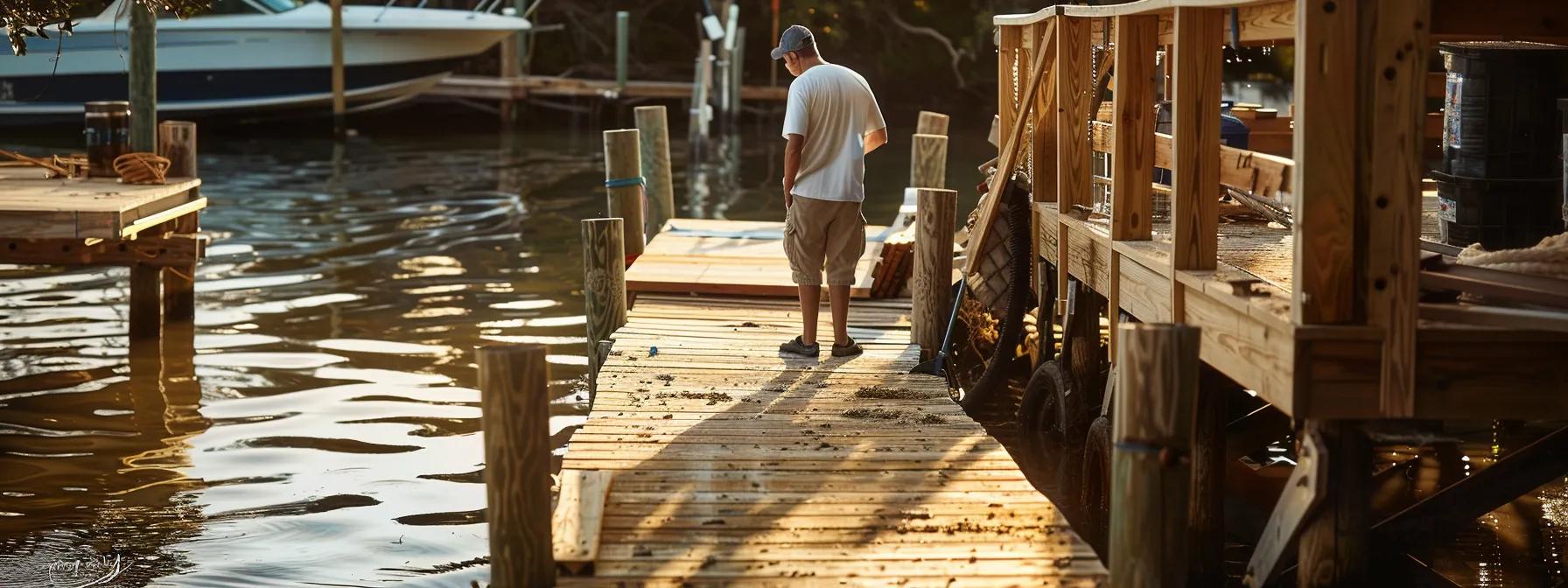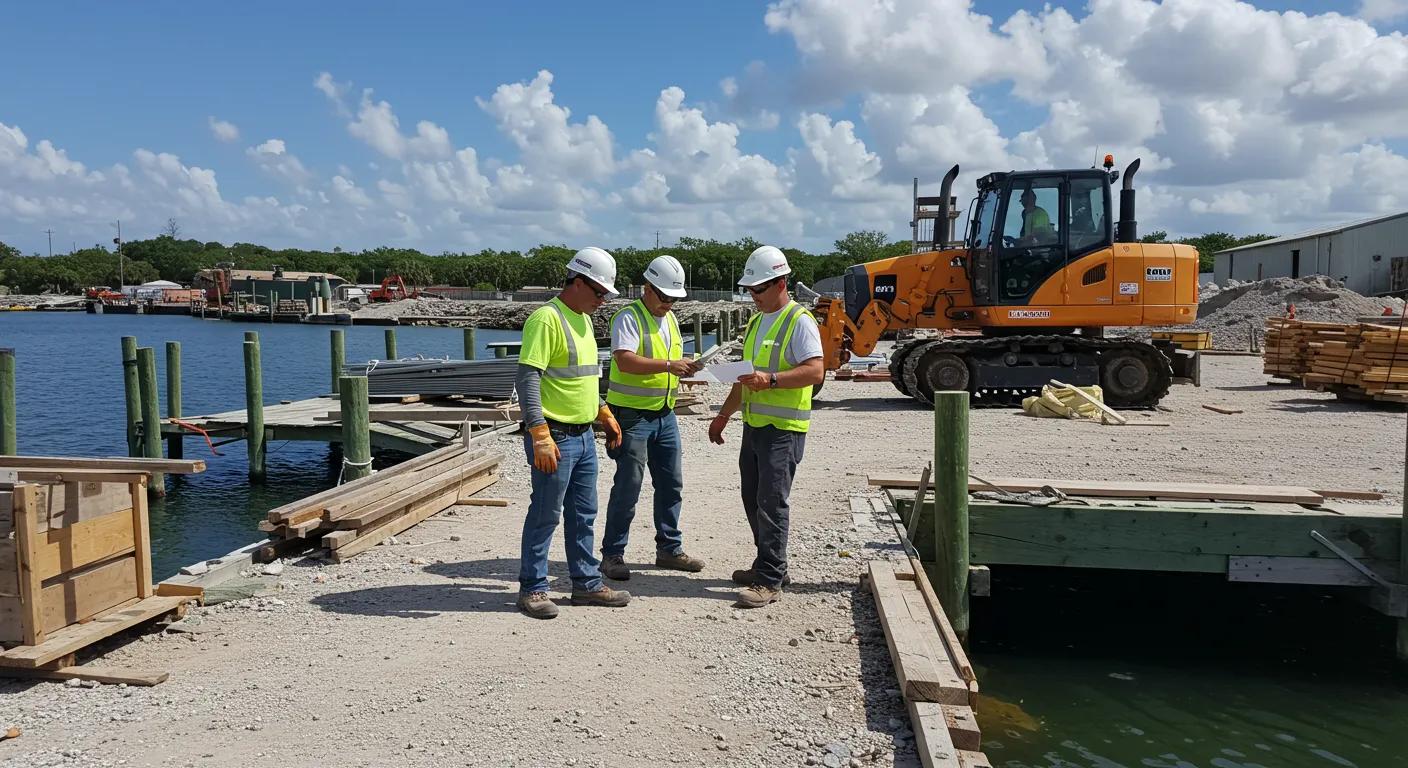Best Wood Options for Durable Dock Construction
Constructing a dock that endures harsh marine conditions requires selecting wood materials that offer strength, durability, and resistance to decay. As a homeowner planning a waterfront project, it is essential to understand the characteristics of hardwoods and softwoods, along with the benefits and limitations of treated lumber. This guide reviews wood features crucial for docklongevity, highlights premium hardwood and dependable softwood options ideal for marine environments, and discusses treatment processes that extend dock lifespan. It also outlines critical selection factors, including local climate, budget, and aesthetics, offering actionable insights on wood preservation and waterproofing to ensure your dock remains stable and visually appealing for years to come.
By the end of this article, you will understand the various wood types available—from Ipe and Teak to Pressure-Treated Southern Yellow Pine—and receive practical maintenance tips to protect your dock’s structural integrity.
Understanding Key Wood Characteristics for Dock Longevity
A resilient dock begins with selecting wood based on its natural resistance to decay, strength, density, grain pattern, and hardness.
Assessing Natural Resistance to Rot and Marine Borers
Water and damp conditions promote fungal growth and insect infestations. Species such as Ipe and Teak naturally contain compounds that deter rot and marine borers. Their inherent resistance helps slow deterioration compared to untreated softwoods, thus lowering maintenance costs and replacement frequency.
Evaluating Wood Strength and Load-Bearing Capacity for Docks
Docks must bear static loads like people and equipment and dynamic forces from waves and wind. Dense hardwoods generally offer higher bending and compressive strength than softwoods. For example, engineered wood products and species like Cumaru can provide enhanced load-bearing capacity, ensuring structural integrity under adverse weather conditions.
Considering Wood Density and Its Impact on Durability
Wood density affects resistance to wear, water absorption, and deformation. Denser woods like Ipe and Cumaru offer superior performance but may be more challenging to work with. In contrast, some lower-density softwoods require chemical treatments to achieve similar durability, making density an important factor in balancing workability with longevity.
How Wood Grain Affects Stability in Dock Building
The direction and structure of wood grain influence dock stability. Straight grain enhances uniform strength and reduces bending or warping, while irregular grain may resist splitting but complicate installation. A uniform grain also improves adhesion of sealants, increasing the dock’s service life.
The Significance of Wood Hardness for Wear Resistance
Hardwoods with high Janka ratings, such as Ipe and Teak, resist abrasion and impacts better than softer species. This durability minimizes surface degradation and the risk of injuries, making high hardness a key factor for docks experiencing heavy foot traffic and environmental stress.
Premier Hardwood Selections for Building Enduring Docks
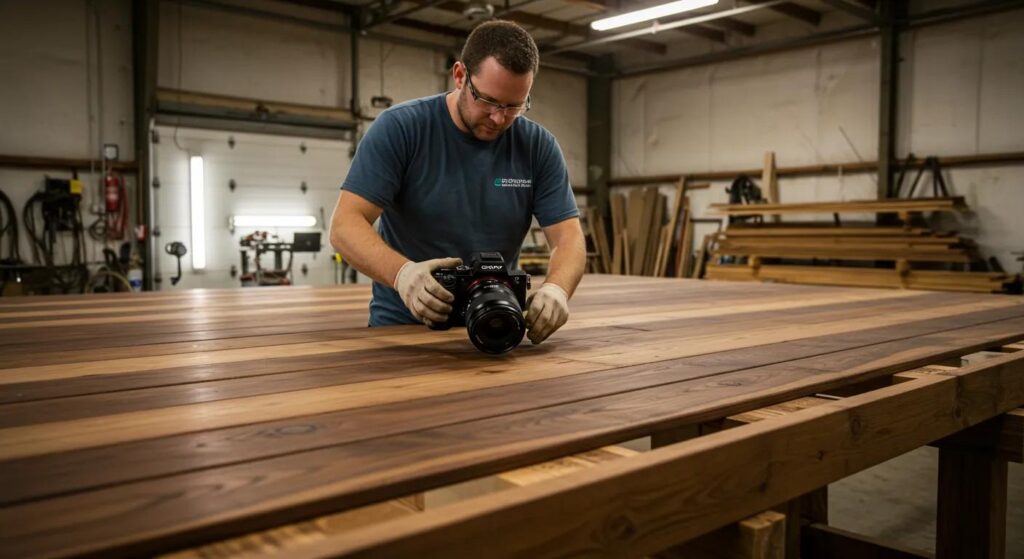
Premium hardwoods combine strength, longevity, and natural resistance to environmental stress, making them ideal for dock construction.
Ipe the Superior Choice for Marine Environments
Ipe is celebrated for its exceptional density, natural oils, and resistance to decay. It withstands constant water exposure without warping and can last over 40 years with minimal maintenance. In addition to its technical advantages, Ipe’s rich, dark hues and fine grain add attractive aesthetic value to waterfront properties.
Teak a Classic Option for Weather-Resistant Docks
Teak is traditionally used in marine settings due to its natural oils and silica content, which impart excellent weatherproofing. Its ability to repel water and resist decay means it only requires occasional maintenance. Although Teak is slightly more costly, its durability and classic golden-brown look make it a smart, long-term investment.
Cumaru a Cost-Effective Durable Hardwood for Docks
Often called Brazilian Teak, Cumaru is popular for its high density and resistance to rot, insects, and fungi. It offers excellent durability and can significantly reduce long-term repair and replacement costs. With its reddish-brown tone, Cumaru is both aesthetically pleasing and affordable without compromising performance.
Greenheart Exceptional Strength for Heavy-Duty Dock Construction
Greenheart is a premium hardwood known for its strength and ability to support heavy loads. It resists marine borers and mechanical damage well, making it ideal for high-traffic docks. Although it may be less available and have longer lead times, its distinctive deep brown color and outstanding durability make it suitable for demanding projects.
Other Notable Hardwoods for Dock Building Success
Additional hardwood options include Jarrah, Bangkirai, and Merbau. Jarrah offers excellent termite resistance and stability, Bangkirai is noted for its vibrant color and natural oils, and Merbau is valued for its high density and overall durability. Homeowners should consider regional availability and maintenance needs when selecting alternative hardwoods.
List of Top Hardwoods for Dock Construction
- Ipe – Unmatched durability and decay resistance; its dense, oily nature ensures long-term stability.
- Teak– Weather-resistant with natural oils providing excellent waterproofing and a classic appearance.
- Cumaru – A cost-effective choice delivering high density and resistance to biological degradation.
- Greenheart – Offers superior strength for heavy-duty applications with an appealing natural color.
- Jarrah – Known for termite resistance and dimensional stability, adding unique design elements.
Recommended Softwood Varieties for Dock Construction
Softwoods are favored for their availability, cost-effectiveness, and ease of handling. Recent advancements in treatment have enhanced their durability for dock applications.
Pressure-Treated Southern Yellow Pine a Popular Dock Building Material
Pressure-Treated Southern Yellow Pine (SYP) is widely used due to its abundant supply and improved resistance to decay through chemical preservatives. It offers good structural strength and is economical, making it a common choice for framing and decking when maintained with regular cleaning and sealant reapplication.
Cedar Natural Resistance for Lighter Dock Structures
Cedar is inherently resistant to decay and insect attack because of its natural oils. Being lightweight, it is ideal for decorative and structural elements such as railings and benches. Its aromatic properties and warm reddish hue add aesthetic value while requiring minimal chemical treatments.
Redwood Beauty and Durability in Specific Dock Applications
Redwood is prized for its rich, warm color and natural decay resistance. Although it is softer than hardwoods, its resin content protects against moisture, and its workability makes finishing and staining easier. Regular sealing and cleaning help maintain redwood’s appeal and extend its lifespan, especially for non-load-bearing applications.
Douglas Fir Strength and Availability for Dock Framing
Douglas Fir is valued for its excellent load-bearing capacity and structural integrity. Its straight grain and uniform texture simplify construction, making it ideal for dock framing. Although less resistant to decay than pressure-treated options, proper sealing can make it a robust and affordable choice for structural components.
Comparing Softwood Lifespans in Dock Building
The table below compares key softwoodspecies regarding lifespan, natural resistance, typical applications, and cost:
| Softwood Species | Average Lifespan (Years) | Natural Resistance Level | Typical Application | Cost Consideration |
|---|---|---|---|---|
| Pressure-Treated Southern Yellow Pine | 15-20 | Moderate-High | Framing, decking | Economical |
| Cedar | 12-18 | High | Railings, decorative | Moderate |
| Redwood | 10-15 | Moderate | Patios, sleepers | Premium |
| Douglas Fir | 15-20 | Moderate | Structural framing | Economical |
| Other Softwoods | 10-15 | Low-Moderate | Variable applications | Varies |
Treated Lumber Considerations for Maximizing Dock Lifespan
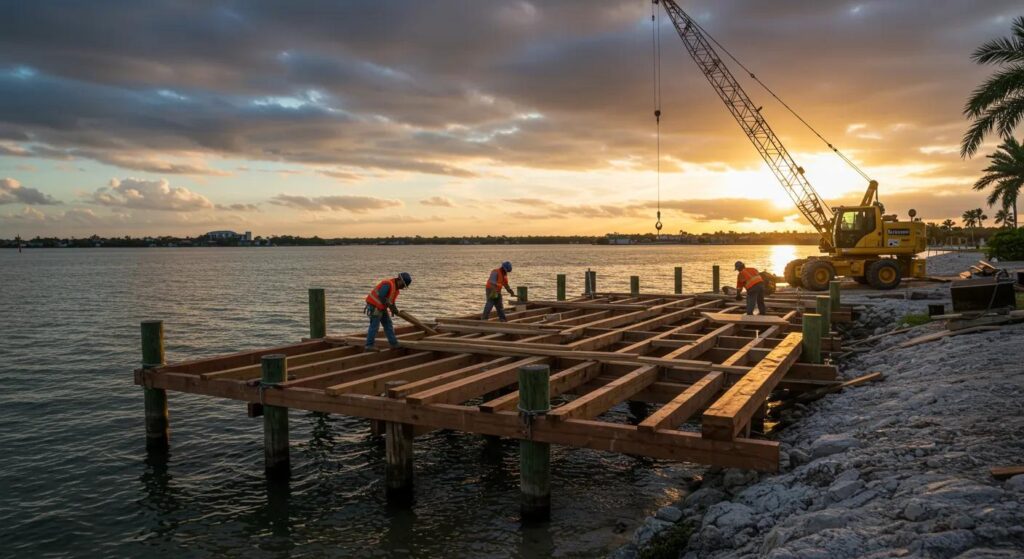
Treated lumber enhances durability by using chemical preservatives to protect wood against decay, insects, and moisture.
Types of Wood Preservatives Used for Dock Lumber
Common preservatives such as alkaline copper quaternary (ACQ), copper azole, and micronized copper stabilize wood and reduce water absorption. Treated wood can significantly reduce decay, offering extended protection when the appropriate preservatives are used and meet regulatory standards.
Understanding Pressure Treatment Processes for Dock Wood
Pressure treatment forces preservatives deep into wood fibers using high-pressure jets. This process ensures that wood becomes more resistant to decay, insect damage, and moisture intrusion, making it ideal for marine environments. It is essential that treated lumber meets industry standards for long-term durability.
Environmental Impact of Treated Wood in Dock Building
Although treated wood provides enhanced performance, its chemicals can leach into the environment if not properly maintained or disposed of. Modern treatment methods have reduced environmental impact and adhere to regulatory standards like those of the EPA. Following recommended maintenance protocols further minimizes ecological risks.
Ensuring Proper Handling and Installation of Treated Dock Materials
Correct handling is vital for treated lumber. Allow boards to dry adequately before installation, seal cut ends to prevent moisture ingress, and use galvanized or stainless steel fasteners to avoid corrosion. Regular inspections and reapplication of sealants are necessary to preserve the wood’s protective treatment.
Longevity Expectations for Treated Wood in Dock Construction
With proper care, treated wood can last 20 to 30 years or more. Diligent maintenance, including routine cleaning and prompt repairs, enhances its life and minimizes replacement costs. Treated lumber hence represents a cost-effective choice for long-term dock durability.
Critical Factors When Selecting the Best Wood for Your Dock
Choosing the right wood involves balancing environmental conditions, budget, maintenance requirements, and aesthetic desires.
Aligning Wood Choice With Your Local Climate and Water Conditions
Regions exposed to high humidity, frequent rain, or saltwater require woods that resist decay and corrosion. In coastal areas, hardwoods like Ipe and Teak are ideal, while inland projects might accommodate less expensive options if well-treated. Consider seasonal temperature variations and sunlight exposure, which can affect wood expansion and contraction.
Budgetary Considerations for Different Dock Wood Options
While hardwoods offer long-lasting durability, they come with higher upfront costs. Softwoods, particularly when pressure-treated, are more economical initially but may require more frequent maintenance. A cost-benefit analysis considering purchase price, maintenance, and replacement expenses helps in selecting the most cost-effective option over time.
Maintenance Requirements for Various Types of Dock Wood
Different wood types have varied upkeep needs. Hardwoods such as Ipe and Cumaru generally require less maintenance, while softwoods often need regular treatments with sealants and preservatives. Understanding these requirements is vital for long-term durability and helps prevent unexpected repair costs.
Availability of Specific Woods for Dock Building in Your Region
Woodspecies availability may vary by region. Premium hardwoods might need to be imported, affecting cost and lead times, while locally sourced options like Southern Yellow Pine or Douglas Fir could be more accessible and cost-effective when properly treated.
Aesthetic Preferences in Choosing Wood for Dock Construction
The visual appeal of your dock is enhanced by woodspecies that offer distinctive colors, grain patterns, and textures. Hardwoods provide rich hues and aging character, while softwoods offer a lighter, natural look that can be easily stained or painted, contributing to the overall market value of your waterfront property.
Table: Comparison of Key Selection Factors for Dock Wood Options
| Factor | Hardwoods (Ipe, Teak, Cumaru, Greenheart) | Softwoods (SYP, Cedar, Redwood, Douglas Fir) | Treated Lumber |
|---|---|---|---|
| Durability | Excellent (30+ years with minimal maintenance) | Moderate (requires frequent maintenance) | Enhanced durability through treatment |
| Structural Strength | High load-bearing capacity | Adequate for framing; may need reinforcement | Improved resistance against decay |
| Aesthetic Appeal | Rich colors and distinctive grain patterns | Lighter tones that can be finished as desired | Varies based on treatment and finish |
| Cost Considerations | Premium pricing; lower lifecycle cost | Economical upfront; higher maintenance costs | Balanced cost with proper upkeep |
| Regional Availability | May require imports; longer lead times | Often readily available locally | Depends on regional suppliers |
Maintaining Your Wooden Dock for Optimal Durability and Appearance
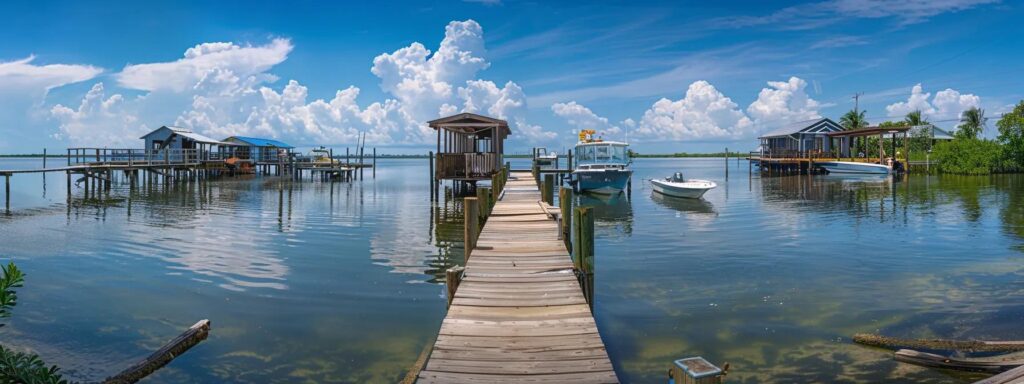
Ongoing maintenance is key to prolonging the life and appearance of your dock.
Regular Inspection Schedules for Your Wood Dock
Seasonal inspections help detect early signs of wear, decay, or structural issues. Check fasteners, joints, and wood surfaces regularly, and address any splintering, fading, or moisture accumulation immediately to prevent further damage.
Effective Cleaning Techniques for Wood Dock Surfaces
Keeping the dock clean enhances appearance and longevity. Remove debris, algae, and salt deposits with environmentally friendly detergents, and consider low-pressure power washing. Routine cleaning helps contaminants stay off the wood, supporting even application of sealants.
Applying Sealants and Stains to Protect Dock Wood
Quality sealants and stains protect the wood from water, UV damage, and daily wear. Reapply protective coatings every one to two years after proper cleaning and sanding to maximize adhesion and extend the dock’s life.
Addressing Common Repairs in Wooden Dock Structures
Prompt repairs like replacing splintered boards, fixing fasteners, and resealing surfaces prevent further damage. Ensure new wood matches the existing grain and color, and use stainless steel or galvanized fasteners to minimize corrosion.
Seasonal Preparation for Your Wood Dock to Ensure Longevity
Adapt maintenance routines to seasonal changes. In cooler climates, prepare for freezing by sealing all surfaces; in warm months, focus on cleaning and UV protection. In coastal regions, routinely wash off salt buildup to prevent deterioration.
Key Takeaways for Building a Long-Lasting Wooden Dock
Your dock is a vital extension of your waterfront property, and choosing the right wood is crucial for its longevity. By understanding wood resistance, strength, density, and grain characteristics, you can build a dock that withstands environmental challenges. Combining the right hardwood, softwood, or treated lumber with regular inspections, cleaning, and protective treatments will ensure that your dock remains both safe and visually appealing over time.
Frequently Asked Questions
Q: What are the most important woodcharacteristics to consider for dockconstruction? A: Key factors include natural resistance to rot and marine borers, strength, load-bearing capacity, density, grain orientation, and hardness.
Q: How do hardwoodand softwoodoptions differ for docks? A: Hardwoods like Ipe and Teak naturally offer high density and decay resistance, while softwoods such as Pressure-Treated Southern Yellow Pine or Cedar are more economical but typically require more maintenance.
Q: Why is pressuretreatment important in dockwoodselection? A: Pressure treatment infuses wood with preservatives that protect against fungi, insects, and water damage, significantly extending the wood’s lifespan in harsh conditions.
Q: How often should I perform maintenance on my wooden dock? A: It is recommended to conduct seasonal inspections quarterly, clean the dock annually, reapply sealants or stains every one to two years, and promptly address any repairs.
Q: Can treated lumberbe an environmentally friendlyoption for docks? A: Yes, modern treatment methods reduce the environmental impact of treated lumber. Using certified preservatives and adhering to proper maintenance guidelines can ensure an effective and sustainable solution.
Q: What should I consider when choosing woodbased on my local climate? A: Consider local water conditions, humidity, temperature fluctuations, and UV or salt exposure. In coastal areas, select woods with high natural decay resistance; inland areas might accommodate well-treated, more economical options.
Q: How can I extend the lifespan of my dockonce it is built? A: Regular maintenance, timely repairs, and proper application of protective treatments, such as sealing and staining, are key practices to keep the dock structurally sound and visually appealing over many years.

